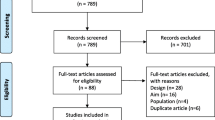Abstract
The aim of this study was to investigate how parents select and use information sources when considering newborn bloodspot screening. Mixed methods approach using semi-structured interviews (n = 18) and a self-completion postal questionnaire (n = 154) conducted with parents of children who had undergone newborn bloodspot screening. Qualitative data was assessed using a thematic analysis approach with quantitative data analyzed using multinomial logistic regression. Parents used a limited range of information. In the UK, maternity services are largely delivered by the midwife and the healthcare practitioner was the main information source for parents, with only half of parents using official health service leaflets. Barriers included the provision of information post-natally and with other non-healthcare materials. Neither number of children, age group, education level, nor income were significantly associated with the number of information sources used. Nor were they associated with the information source indicated as most important. The midwife is well placed to act as a gatekeeper for parents seeking information about newborn bloodspot screening. Even when additional sources are used, the midwife remains a prominent source of information. Furthermore, the use of written materials is dependent upon appropriate delivery and consequently delivery is essential to information use.
Similar content being viewed by others
Notes
The booklet is available at: http://www.screening.nhs.uk/annbpublications (accessed 10th November 2011)
References
Araia M, Chakraborty P, Gall K, Honeywell C, Milburn J, Ramsay T, Wilson B (2010) Factors associated with mothers’ knowledge of and satisfaction with newborn screening education. In: APHL Newborn Screening and Genetics Testing Symposium (Orlando, FL). Available at: http://www.aphl.org/profdev/conferences/proceedings/Pages/2010APHLNBSGTSymposium.aspx
Arnold CL, Davis TC, Frempong JO, Humiston SG, Kennen EM, Lloyd-Puryear M, Bocchini A (2006) Assessment of newborn screening parent education materials. Pediatrics 117:320–325
Boyatzis RE (1998) Transforming qualitative information. Sage, Thousand Oaks
Campbell E, Ross LF (2004) Incorporating newborn screening into prenatal care. Am J Obstet Gynecol 190:876–877
Case DO, Andrews JE, Johnson JD, Allard SL (2005) Avoiding versus seeking: the relationship of information seeking to avoidance, blunting, coping, dissonance, and related concepts. J Med Libr Assoc 93:353–362
Creswell JW, Plano Clark VL (2007) Designing and conducting mixed methods research. Sage, Thousand Oaks
Davey A, French D, Dawkins H, O’Leary P (2005) New mothers’ awareness of newborn screening, and their attitudes to the retention and use of samples for research purposes. Genom Soc Policy 1:41–51
Davis TC, Humiston SG, Arnold CL, Bocchini JA Jr, Bass PF III, Kennen EM, Bocchini A, Kyler P, Lloyd-Puryear M (2006) Recommendations for effective newborn screening communication: results of focus groups with parents, providers, and experts. Pediatrics 117:S326–S340
Detmar S, Hosli E, Dijkstra N, Nijsingh N, Rijnders M, Verweij M (2007) Information and informed consent for neonatal screening: opinions and preferences of parents. Birth 34:238–244
Fielding NG, Lee RL (1998) Computer analysis and qualitative research. Sage, London
Hargreaves K, Stewart R, Oliver S (2004) Pilot study of pre-screening parent leaflet on newborn blood spot screening and health professional communication guidelines. UK Newborn Screening Programme Centre, London
Hargreaves K, Stewart R, Oliver S (2005) Informed choice and public health screening for children: the case of blood spot screening. Heal Expect 8:161–171
SPSS Inc (2008) SPSS for Windows, Rel. 17
Miles MB, Huberman AM (1994) Qualitative data analysis: an expanded sourcebook. Sage, Thousand Oaks
Parsons EP, King JT, Israel JA, Bradley DM (2007) Mothers’ accounts of screening newborn babies in Wales (UK). Midwifery 23:59–65
Stapleton H, Kirkham M, Thomas G (2002) Qualitative study of evidence based leaflets in maternity care. Br Med J 324:639–644
Stewart R, Oliver S (2003) What is known about communication with parents about newborn bloodspot screening? UK Newborn Screening Programme Centre, London
Strauss AL (1996) Qualitative analysis for social scientists. Cambridge University Press, Cambridge
Tluczek A, Orland KM, Nick SW, Brown RL (2009) Newborn screening: an appeal for improved parent education. J Perinatal-Neonatal Nurs 23:326–334
Tymstra T (1986) False positive results in screening tests: experiences of parents of children screened for congenital hypothyroidism. Fam Pract 3:92–96
UK Newborn Screening Programme Centre (2008) Guidelines for newborn blood spot sampling. A UK National Screening Committee, London
Wilson TD (1999) Information behaviour: an interdisciplinary perspective. Inf Process Manag 33:551–572
Acknowledgments
The authors would like to thank Mrs. Elaine Hanmer at Alder Hey Children’s NHS Foundation Trust, Mrs. Liz Eccleston at East Cheshire NHS Trust as well as the NCT and Sure Start branches for their assistance with recruitment. Thanks also to all the parents who took part, those involved in the development of the questionnaire, including representatives of Save Babies Through Screening Foundation UK, Dr. Mairi Levitt at Lancaster University for her comments and support and to Mrs. Dawn Fox-Davies and Dr. Ingrid Holme for their constructive comments on earlier drafts of this article.
Competing interests
None declared.
Funding
Dr. S.G. Nicholls was funded by an Economic and Social Research Council (ESRC) Postgraduate Studentship PTA-031-2006-00013.
Author information
Authors and Affiliations
Corresponding author
Rights and permissions
About this article
Cite this article
Nicholls, S.G., Southern, K.W. Parental information use in the context of newborn bloodspot screening. An exploratory mixed methods study. J Community Genet 3, 251–257 (2012). https://doi.org/10.1007/s12687-012-0082-4
Received:
Accepted:
Published:
Issue Date:
DOI: https://doi.org/10.1007/s12687-012-0082-4




